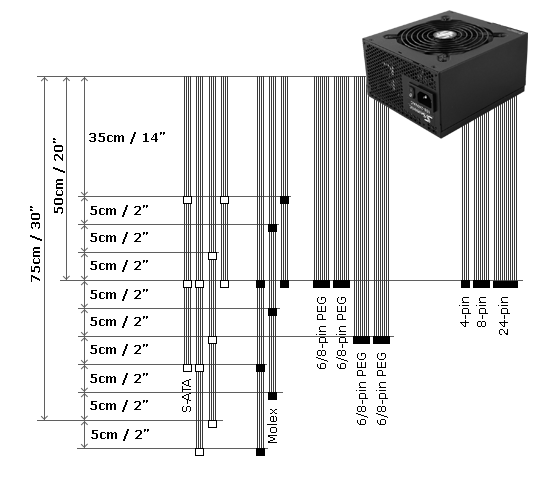Seasonic M12D 850W: DC-to-DC Perfection?
by Christoph Katzer on November 26, 2008 12:00 AM EST- Posted in
- Cases/Cooling/PSUs
Cables and Connectors

With the power supply of this caliber, the cables of course come with sleeving. The maximum cable length is 80cm (32"), which is long enough for most cases. However, the minimum length of 50cm (20") on the ATX connectors is only average and may not work well in full-tower cases -- particularly cases where the PSU is on the bottom. Such cases usually require cable lengths of at least 60cm if you want to route the cables nicely and keep from impeding airflow.

Most of the cables are detachable and come in an extra bag Seasonic provides. The 24-pin ATX connector, 4-pin ATX12V and 8-pin EPS12V connectors, two 60cm 6-pin PEG connectors, and SATA harness are all affixed to the power supply; all of the remaining cables are optional. The power supply provides a total of four PEG connectors, which is decent for an 850W power supply, but it's certainly possible to power higher end configurations (i.e. triple SLI -- even if NVIDIA refuses to certify "smaller" PSUs for such use).
The Fan

Sanyo Denki, a renowned Japanese fan maker, produces the 120mm San Ace fan installed in this power supply. The model number is 9S1212H403.










45 Comments
View All Comments
CEO Ballmer - Saturday, November 29, 2008 - link
I have one, works nicely!http://fakesteveballmer.blogspot.com">http://fakesteveballmer.blogspot.com
InterClaw - Friday, November 28, 2008 - link
How much power does the M12D consume while in standby mode (switch on) running on 230Vac?Christoph Katzer - Saturday, November 29, 2008 - link
I will have a small update on that because I did some further testing. The M12D has an incredible high sb-efficiency with up to 76% which is really good compared to 40-ish% of many others.daar - Wednesday, November 26, 2008 - link
Can someone explain the significance for the DC-to-DC configuration over what they or other PSU manufacturers normally do? I mean other than the odd efficiency curves, it doesn't really provide anything unique when compared to say, the Enermax.PrinceGaz - Wednesday, November 26, 2008 - link
I'm guessing here and haven't checked my "facts", but I'm guessing the DC-DC conversion helps because it allows the PSU manufacturer to concentrate most of their effort on providing a clean and efficient +12V rail from the AC supply, then tag the conversion circuitry onto the end of that to generate the less critical +5V and +3.3V rails.The alternative is to have seperate circuitry for generating +12V, +5V, and +3.3V all individually from the AC supply.
JarredWalton - Thursday, November 27, 2008 - link
I believe that's right - it's easier to do 12V DC to 3.3V/5V DC than it is to do 120V/230V AC to the same, so you do one good AC-to-DC conversion and then a couple simpler DC-to-DC conversions.mindless1 - Saturday, November 29, 2008 - link
It's not necessarily easier, it's just that if you first convert to 12V alone you have maximized the amount of 12V current a single transformer of a given size can produce, then let that be the primary feedback voltage to determine switching pulse width. That typically also means you can have higher ratios of 12V to 5V or 3.3V current without going out of spec. It makes more and more sense to do so when a PSU is of high wattage as it's then expected to have so much more 12V current consumption as a % of total power used.Mr Perfect - Wednesday, November 26, 2008 - link
Maybe you could put a bug in Seasonic's ear about their "little" 120mm fan? Looking at the acoustic results, you can't help but wonder what a 140mm fan could have done for that curve. A 140mm might have shifted the whole curve down two or three decibels.piroroadkill - Thursday, November 27, 2008 - link
Bear in mind half of the fan is usually covered towards the front of the PSU, I'm really not sure a 140mm fan helps at all, because that's simply more airflow that's blocked by a baffle. This baffles me (hurr)... Seems like 120mm is perfectly adequete, and more to the point, if you so wish to change the fan yourself, at least 120mm is a standard sizeMr Perfect - Thursday, November 27, 2008 - link
140s are mainly interesting because they produce any given amount of airflow at a lower RPM then 120s. So rather then run it at the same RPM as the 120, and just block more airflow, they could run it at a lower RPM while producing the same airflow. Then maybe it would top out around 28DB instead of a 31DB, or idle at 15db instead of 17. Hopefully there wouldn't be a need to change the fan then.